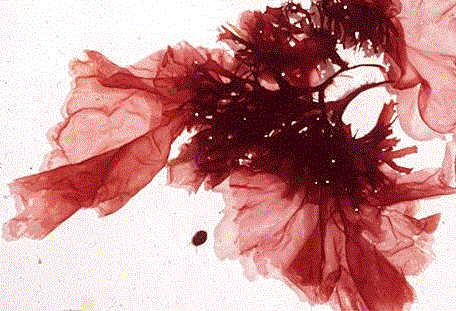Introduction to the Rhodophyta
The red "algae"


Red algae are red because of the presence of the pigment phycoerythrin; this pigment reflects red light and absorbs blue light. Because blue light penetrates water to a greater depth than light of longer wavelengths, these pigments allow red algae to photosynthesize and live at somewhat greater depths than most other "algae". Some rhodophytes have very little phycoerythrin, and may appear green or bluish from the chlorophyll and other pigments present in them.
In Asia, rhodophytes are important sources of food, such as nori. The high vitamin and protein content of this food makes it attractive, as does the relative simplicity of cultivation, which began in Japan more than 300 years ago.
Some rhodophytes are also important in the formation of tropical reefs, an activity with which they have been involved for millions of years; in some Pacific atolls, red algae have contributed far more to reef structure than other organisms, even more than corals. These reef-building rhodophytes are called coralline algae, because they secrete a hard shell of carbonate around themselves, in much the same way that corals do.
For more information:
Algae: The Forgotten Treasure of Tidepools
is an excellent exhibit at Sonoma State on California tidepool algae, including
red algae.
Visit Michael Rasser's pages on FOSSIL CORALLINE ALGAE (Corallinaceae: Rhodophyta).
For more on the biology and economic uses of seaweeds, including rhodophytes, visit the marine plants database of the DELTA Project, or the Seaweed Information Server maintained at University College Galway, Ireland. Or go to the exhibit on Porphyra, a typical red alga, from the Protist Image Database at the University of Montreal.
Derek Keats at the University of Western Cape, South Africa, has put extensive information about the nongeniculate coralline algae on-line. David Hills has a page on Pleistocene crustose coralline algae.
For a fuller listing of on-line phycological collections resources, try our Phycological Collection Catalogs Listings.


